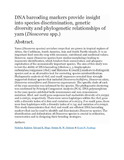| dc.contributor.author | Kipkiror, Nicholas | |
| dc.contributor.author | Muge, Edward K. | |
| dc.contributor.author | Ochieno, Dennis M. W. | |
| dc.contributor.author | Nyaboga, Evans N. | |
| dc.date.accessioned | 2022-11-16T09:00:29Z | |
| dc.date.available | 2022-11-16T09:00:29Z | |
| dc.date.issued | 2022-11-14 | |
| dc.identifier.uri | https://doi.org/10.1007/s11756-022-01244-y | |
| dc.identifier.uri | https://link.springer.com/article/10.1007/s11756-022-01244-y#citeas | |
| dc.identifier.uri | http://ir-library.mmust.ac.ke:8080/xmlui/handle/123456789/2136 | |
| dc.description.abstract | Yams (Dioscorea species) are tuber crops that are grown in tropical regions of Africa, the Caribbean, South America, Asia and South Pacific islands. It is an important food security crop with economic, nutritional and medicinal values. However, many Dioscorea species have similar morphology leading to inaccurate identification, which hinders their conservation and adequate exploitation of the economically important species. The aim of this study was to test the ability of DNA barcoding [ribulose 1, 5-bisphosphate carboxylase/oxygenase (rbcL) and Maturase K (matK)] markers to distinguish species and as an alternative tool for correcting species misidentification. Phylogenetic analysis of rbcL and matK sequences revealed four strongly supported distinct species that included Dioscorea bulbifera, Dioscorea alata, Dioscorea minutiflora and Dioscorea cayennensis. The specific clade of each of the yam accession was informed by the species. The phylogenetic clustering was confirmed by Principal Component Analysis (PCA). DNA polymorphism in the yam species exhibited both synonymous and non-synonymous mutation. RbcL and matK gene sequences had nucleotide diversity of 0.00392 and 0.00632, respectively. There were seven haplotypes within the rbcL gene with a diversity index of 0.800 and variation of 0.00374. For matK gene, there were four haplotypes with a diversity index of 0.745 and variation of 0.00956. This study demonstrates that rbcL and matK are efficient DNA barcoding markers that can be used to identify and discriminate Dioscorea species. The identification and delimitation of Dioscorea species is crucial in utilization, conservation and in designing their breeding strategies. | en_US |
| dc.language.iso | en | en_US |
| dc.publisher | Springer | en_US |
| dc.subject | DNA barcoding, markers, insight, species discrimination, genetic diversity, phylogenetic, relationships, yam (Dioscorea spp.) | en_US |
| dc.title | DNA barcoding markers provide insight into species discrimination, genetic diversity and phylogenetic relationships of yam (Dioscorea spp.) | en_US |
| dc.type | Article | en_US |

